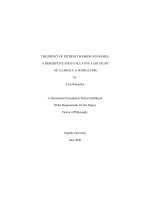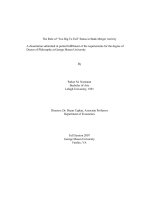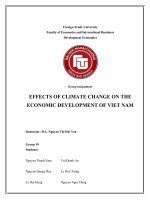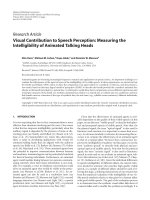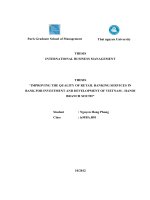Measuring the impacts of internet banking to bank performance
Bạn đang xem bản rút gọn của tài liệu. Xem và tải ngay bản đầy đủ của tài liệu tại đây (160.8 KB, 14 trang )
Journal of Internet Banking and Commerce
An open access Internet journal ()
Journal of Internet Banking and Commerce, August 2015, vol. 20, no. 2
Measuring the Impacts of Internet Banking to
Bank Performance: Evidence from Vietnam
VAN DINH
Falcuty of Finance and Banking, VNUUniversity of Economics and
Business, Hanoi, Vietnam, Tel: +84904641686
Email:
UYEN LE
Falcuty of Finance and Banking, VNUUniversity of Economics and
Business, Hanoi, Vietnam
PHUONG LE
Falcuty of Finance and Banking, VNUUniversity of Economics and
Business,Hanoi,Vietnam
Abstract
Internet banking is an innovative service in the banking industry. However,
researching about the impact of internet banking to bank’s performance is rarely
seen. In Vietnam, no research has been found recently by researchers. The main
objective of this study is to evaluate the impact of internet banking to
performance (profitability ratios, noninterest operating expenses and incomes) of
JIBC August 2015, Vol. 20, No.2
-2-
banks in Vietnam in the period from 2009-2014. The study uses random effect
model (REM) and fixed effect model (FEM) to estimate the relationships between
Internet indicators and bank’s performance. The results from the regression
model showed that internet banking had an impact on bank profitability through
an increase of income from service activities. However, the impact level was low
and had a lag time of over 3 years, which is longer than findings from previous
studies.
Keywords: Internet banking; Commercial bank; Performance ratios; Service
channel
© VAN DINH, 2015
INTRODUCTION
The competition is fierce in the economy and particularly in banking sector.
Banks will fully exploit all factors available to help banks gain market share and
retain customers, which become increasingly hard in the digital age. Consumer is
shifting from tradition channels to digital ones and the multichannel model now is
the popular trend in the banking industry. As the earliest-adopted digital channel,
Internet banking is currently the feature can be expected to find at a commercial
bank. Since it was implemented, customers were able to do their banking with
the speed, convenience and control more than ever. As a result, banks enhance
customer satisfaction and increase their user loyalty–the ultimate goals of all
banks in current situation. On the other side, Internet banking is a service with
great potential. It would become a decent source of profits for banks; reduce
bank’s operating expenses so ultimately enhance bank performance. To date,
Internet banking is not just an element to compete for market share but becomes
an essential service to provide, if not banks would face the chance of losing their
market share or bad effects to their brand.
There are good reasons to expect that Internet banking will spread expeditiously
and have a great impact on banks performance. However, it seems not to be the
case in Vietnam. Though available in since 2004, the scale of Internet banking is
relatively small. Till 2014, total users of this service have only reached 6 million,
equivalent 17% of total Internet users which is even lower than the average of
Asia-Pacific. Therefore, commercial banks are facing the risk of not meeting
customer’s expectations especially when e-commerce is gradually developing
which caused the rising need of online payment mechanisms. According to
estimates, total value of online shopping increases more than 57 million dollars
annually. This is an opportunity for both e-commerce enterprises and financial
service provider. In fact, according to Vietnam ICT Index 2014 report, 13/25
surveyed commercial banks reported a ratio of digital transaction (through
JIBC August 2015, Vol. 20, No.2
-3-
Internet banking, mobile banking) value less than 2% while these channels have
been offered before 2004. The data suggests that banks have not valued
properly or had an effective strategy to exploit the huge potential of these
channels, especially the Internet banking platform. In order to shed a light on that
problem, the question of how internet banking affects banks’ performance in
Vietnam needs to be addressed. However, to date few empirical studies are
available regarding the impact of Internet banking on the financial performance of
commercial banks in Vietnam.
The purpose of this paper is to identify and estimate the impact of Internet
banking from the commercial banks’ perspective. To be specific, this study
attempted to examine the impact on profit, operating cost, and profitability of the
adoption of the Internet as a distribution channel. A sample of 20 banks,
accounted for about a half of the total number of commercial banks, which is
approximately 70% of total asset of Vietnam banking sector over the period
2009–2014 is used. From the regression results, the authors hope to provide
practical recommendations for banks to improve and develop that delivery
channel in an optimal way. The results suggest that Internet banking adoption
affects the income and consequently the profitability of commercial banks in
Vietnam. This impact is gradual and takes a time lag of three years to be
statistically significant.
This article is divided in four parts. First, the introduction presents an overview of
the article. The second part describes theoretical basis and methods of analysis.
Part three provides results from regression analysis and discussion. The fourth
part offers some conclusions and recommendations for commercial banks in
Vietnam.
THEORETICAL BASIS AND METHODS
Theoretical basis and analysis framework
Internet banking is a service of electronic banking (E-banking). According to
Comptroller’s Handbook [1], it enables bank customers to access accounts and
general information on bank products and services through the Internet. Besides
existing channels such as ATM, PC banking, Home banking, the adoption of
Internet banking adds another delivery channel and forms the multichannel
model seen widely in banking industry nowadays. Internet banking holds huge
potential as a convenient and efficient delivery which has not been provided
before by banks. At its ultimate end, Internet banking may become a new
business model totally different from the traditional one (Internet-only model –
bank with no branch, all banking activities is performed online).
The applications of technology and Internet banking in particular have brought
great changes to the banking industry. Agboola [2] emphasized that banks have
JIBC August 2015, Vol. 20, No.2
-4-
to invest in technology, modernize their systems to improve quality, efficiency
and speed in delivering services; otherwise they may lose their positions in the
competitive race with the rivals. Customer expectations are changing and shifting
due to advances in technology. To satisfy those subtle needs, multichannel
delivery model is applied and proven to be a success. Such a system employs a
unified interface across all channels. Customer’s preferences and activities are
transferred across mediums and thus ensure functionality remains reliable
regardless of the customer’s preferred device. This forms and enhances
customer’s trust and loyalty to the banks which is increasingly important to
Vietnamese banks in the integration trend. Besides from those indirect impacts, a
modern service such as Internet banking can have direct impacts on banks’
performance such as bank income, operating costs, and in turn bank profitability.
First, considering the impact of Internet banking to bank’s income, banks
themselves have different opinions and there is no consensus on this issue.
Some feel, in essence, Internet banking lowers their marginal profit. Providing
Internet banking is only a measure to satisfy big customers who need to do their
banking online [3]. Other banks argue that this channel increases noninterest
income if banks provide services customers need through the Internet. DeYoung
et al. [4] analyzed operations of more than 400 banks in United States and
concluded that Internet banking increases bank’s revenues from deposit service
charges. Other researches in developing countries such as Iran and Kenya
recently show that Internet banking increase bank’s profit [5,6].
Banks expect the application of information and technology reduces operating
expenses due to the decrease in the number of employees needed in bank’s
daily operations. Hernando and Nieto [7] found that operating expenses increase
after the adoption of Internet banking, then it gradually decrease over time and
become significant three year after adoption. However, DeYoung [4] found no
evidence that Internet channel is a low-cost substitute for the physical branch
delivery. Moreover, there is evidence showing that the Internetrelated costs
increase, for example the cost for call center that supports customer 24/7 or
higher average wages for a more skilled labor force to run the more sophisticated
delivery system.
Due to the inconsistency in the above results, it is hard to predict the impact of
Internet banking on bank’s profitability. Sullivan [8] found no systematic evidence
that banks were either helped or harmed by offering this channel. Furst et al. [9]
examined a larger number of banks which offer the Internet channel, found that
the return on equity (ROE) tended to be higher for banks with Internet banking.
A number of studies showed a positive relationship between the adoption of
Internet banking and bank’s profitability [4,10]. This effect is expressed gradually
and becoming significant two to three years after the adoption, in other words,
there is a time lag on the impact of Internet banking. In that period, banks may
experience a drop in profits due to the high initial investment cost for a new
delivery system.
JIBC August 2015, Vol. 20, No.2
-5-
In general, studies in developed countries shows that the Internet channel has a
positive impact on non-interest income reduce operating expenses and as a
result, enhance bank’s profitability. However in developing countries, these
effects were ambiguous. Malhotra and Singh, Khrawish and Al-Sa’di [11,12]
found no evidence of the relationship between Internet banking and bank
performance. Furthermore, the study concluded that the Internet delivery channel
have affected negatively to some bank profitability due to the higher operating
expenses.
METHODS
Hypotheses: Same with developing countries, due to a relatively low level of
information and communication technology infrastructure, Internet banking in
Vietnam’s banking sector has developed somewhat late and still considered a
new way to do banking. The level of competition is not so fierce and drives down
all the profit from this service, thus there are reasons to assume Internet banking
increase income for commercial banks in Vietnam. Relating to operating cost,
this is always a motive for banks to invest in infrastructure, Internet banking is not
an exception. If the above assumption holds, the adoption of Internet banking
would consequently increase the profitability of banks.
Therefore, research questions and hypotheses are given as follows:
Question 1: Does Internet banking have an impact on profitability of commercial
banks in Vietnam? How is the level of that impact?
Hypothesis H1: Internet banking has a positive impact on profitability of
commercial banks in Vietnam.
Hypothesis H0: Internet banking does not have a positive impact on profitability
of commercial banks in Vietnam.
Question 2: Does Internet banking have an impact on operating expenses in
Vietnam? How is the level of that impact?
Hypothesis H2: Internet banking reduces operating expenses of commercial
banks in Vietnam.
Hypothesis H0: Internet banking does not reduce operating expenses of
commercial banks in Vietnam.
Question 3: Does Internet banking have an impact on income of commercial
banks in Vietnam? How is the level of that impact?
Hypothesis H3: Internet banking increases income of commercial banks in
Vietnam.
Hypothesis H0: Internet banking does not increase income of commercial banks
in Vietnam.
Data: The dataset used in this study includes 20 commercial banks in Vietnam in
the period 2009 – 2014, of which, 2 are stateowned commercial banks and 18
are joint-stock commercial banks. Joint venture banks and foreign bank branches
JIBC August 2015, Vol. 20, No.2
-6-
are not included due to foreign factors which may cause the analysis results to
be biased. The selected banks are accounted for about a half of the total number
of commercial banks, which is approximately 70% of total asset of Vietnam
banking sector. Thus this sample can be considered as the representative for
Vietnam banking industry with 3 large banks (total asset over 500 trillion
VNĕ), 7 medium banks (total asset 100 – 300 trillion VNĕ), 10 small
banks (total asset under 100 trillion VNĕ). These banks have completed
financial reports in the study period and the Internet banking information.
Commercial banks in Vietnam have adopted the Internet delivery channel since
2004 beside traditional channels such as branch. Due to the relatively weak
technology conditions, Vietnam banks need a long period to test and improve the
channel. Previous studies showed that the impact of Internet banking has a time
lag of at least two years [7,10]. Moreover, 2009 is the year commercial banks in
Vietnam started adopting Internet banking broadly. Therefore, the research
period starts from 2009 and lasts until 2014 to account for the above facts,
ensure a sufficient number of observations as well as capturing more
contemporary data.
Regression analysis model: From the assumptions above, we propose a 3variable linear regression model to evaluate the impact of the Internet banking
service to operational efficiency of Vietnamese commercial banks.
The regression equation takes the following form:
PERFORMANCEi,t
=
α
+
+
+
i,t
(i, t are bank index and time of observation, respectively)
PERFORMANCEi,t is the indicator of the operational efficiency of the bank i at
time t, including the profitability ratio (ROE, ROA), operating costs (NIE/A), noninterest income (NONII/A).
Consists of 3 variables controlling the performance indicators of the bank i
at time t: ln(A) (asset size), Deposit/A (deposits / total assets ratio), Loan/A
(loans / total assets ratio). This group index will explain the difference between
the scale, operational and business structure between banks and data lagged 1
year was taken to avoid endogenous effects which may occur in the model.
includes 3 dummy variables which represent the time period when
commercial banks started to transact on Internet banking to year t: MULTI1 (the
impact of new Internet banking when put into use), MULTI3 MULTI4 (impact of
Internet banking with latency 3 years and more than 4 years).
JIBC August 2015, Vol. 20, No.2
-7-
timedumt: dummy variables for each year to eliminate the influence of the macroeconomic conditions (e.g. crisis, business cycle) to the bank performance over
the period.
Methods of regression model: Due to the banking sector in Vietnam as some
banks occupy large market share as well as the impact of experience effect in
the application of new technology, after running OLS regression model, we
conduct Breusch- Pagan and Hausman tests. The test results showed that the
homocedasticity error exists in the pattern and the random effects models (REM)
fit 2 models of ROA and NONII/A, the fixed effects model (FEM) fit 2 models of
ROE and NIE/A. So we decided to use REM quantified by means of generalized
least squares (GLS) to correct the homocedasticity for 2 model ROA and
NONII/A. The remaining 2 models ROE and NIE/A using FEM. Before that, we
will perform Wilcoxon's rank-sum test to a preliminary measure of the influence of
Internet banking on the Vietnamese commercial banks performance.
FINDINGS
Preliminary evaluation of the influence of internet banking on the Vietnamese
commercial banks’ performance is shown in Table 1.
Table 1: Descriptive Data
N
ROA
ROE
NONII_A
NIE_A
DE_A
LO_A
LN_A
MULTI1
MULTI3
MULTI4
120
120
120
120
120
120
120
120
120
120
Minimu
m
.0003
.0039
-.0034
.0047
.5099
.2104
15.5889
0
0
0
Maximu
m
.0475
1.5839
.0120
.0444
.9647
2.7164
20.1722
1
1
1
Mean
.0108
.1224
.0031
.0182
.7281
.5731
17.9653
.11
.13
.37
Std.
Deviation
.0064
.1466
.0023
.0055
.0928
.2433
1.1532
.312
.341
.486
Previous researches showed that the impact of Internet banking take a time lag
at least 2 years so the authors try to do similar test [7,10]. The indicators of
banking performance from 2009 to 2011 will be tested and they are divided into 2
groups: Group 1 (group has Internet banking) and group 2 (group has no Internet
banking) in the period 2009 - 2011. If results show any differences between 2
groups, it suggests that Internet banking affects operations of banks with a lag of
2 years.
JIBC August 2015, Vol. 20, No.2
-8-
Due to the characteristics of the banking sector in Vietnam with some strong
banks dominate market share, the data is likely under skewed distribution form,
and thus, Wilcoxon’s rank-sum test (a nonparametric test) will be used in this
evaluation instead of t-test. The null hypothesis is that there is no difference
between banks performance of two groups (Table 2).
Table 2: Results of Wilcoxon rank-sum test for bank performance 2009 – 2011
W
p-value
ROA2011 – ROA2009
36
0,8784*
ROE2011 – ROE2009
33
0,6451*
NONII/A2011 –
NONII/A2009
38
1*
NIE/A2011 – NIE/A2009
41
0,798*
Ln(A2011) – Ln(A2009)
26
0,2327
* estimated value
Results in Table 1 (with p-value> 0.05) showed no evidence of the influence of
Internet banking on bank performance during the period 2009-2011 or internet
banking would not affect a bank’s performance after 2 year of adopting. Results
are similar to those of other studies in developing countries [11,12] as well as in
developed countries in the new era of Internet banking life [8,9]. That suggests
two cases which may occur: Internet banking has not affected bank performance
or the impact of Internet banking has larger latency than two years. This is also
the basis for group selecting the dummy variable Internet banking MULTI in the
regression model.
The test shown above provides a preliminary picture of the impact of Internet
adoption on the performance of banks operating multichannel in Vietnam. That
effect is best represented by the estimated coefficients in the multivariate
analysis below since the regressions including control variables for other effects
might cause biased to the final result in Table 3.
The regression results show that the variables MULTI3 and MULTI4 are
statistically significant only in the model of ROE and NONII/A, which means
Internet banking has a positive impact on profitability and non-interest income of
banks but with the time lag 3 years and very small degree of influences (beta
MULTI3 is 0.000791, beta MULTI4 is 0.000859). Findings also reject the
JIBC August 2015, Vol. 20, No.2
-9-
hypothesis that Internet banking reduces operating costs. Some of the control
variables (ln (A) and deposit/A) show statistically significant. To summarize, two
out of three hypotheses are proven to be true and the argument about a greater
time lag is verified.
DISCUSSION
Internet banking is a promising delivery channel in Vietnam and the purpose of
this article is to fill the gap of the lack of studies in this particular discipline. In the
previous studies, researchers found no evidence of the link between Internet
banking and banks’ performance with a two-year’ time lag in some developing
countries. This article, use data of commercial banks in Vietnam, strengthen and
expand these findings. The results of the constructed regression model show that
Internet banking has positive impacts on banks’ income and in turn, banks’
profitability. These effects are gradual, becoming significant three years after the
adoption of Internet banking. In other words, this is the evidence to prove that, in
developing countries, digital channels such as Internet banking still bring benefits
to banks though these effects are observable after a longer period than in
developed countries.
The scale of the impact on income is relatively small (less than 0.1% increase
after 3 years adopting Internet banking). It suggests another conclusion. Internet
banking functions as a delivery channel to satisfy the increasingly complicated
demand of customers, who in turn feel trust in and loyalty to the bank, not as a
main source the bank can profit from.
The relatively small size of Internet banking, total number of users to be specific,
is also a reason to explain for the low level of impact this channel contributes to
banks’ performance. According to statistics, total users of this service have only
reached 6 million in the first half of 2014, merely 17% of total Internet users
which is even lower than the average of Asia-Pacific, not mentioned that Internet
banking has been adopted in Vietnam for a relatively long time. The number
suggests that banks have not appreciated and have a proper plan to develop this
delivery channel. Products and services currently offered through Internet
banking in Vietnam is not diversified and attractive to customers; the complicated
in register procedure and using process also prevent a large part of potential
user. The result is only 12% of total number of banks’ current accounts are using
Internet banking, this is a great loss which can turn to real profit if banks have
better plan to exploit their customer base.
Beside an increase in profit, banks also expect the adoption of Internet banking
to reduce operating costs due to cutting spending for operations and fixed assets
at the bank branches. The research results indicate the operating expenses have
not been affected by the new channel. Added to the low impact of Internet
banking on banks’ income, these results suggest that Internet banking functions
JIBC August 2015, Vol. 20, No.2
- 10 -
as a complement not a substitute for traditional distribution channels such as
branch. This would be investigating more in future studies.
Table 3: Summary results of regression models
ROE
0.048641
0.316
0.103327 *
0.056
0.138733 **
0.030
-0.000592
0.989
ROA
0.001300
0.424
0.000277
0.866
0.000929
0.593
-0.001525 **
0.041
NIE/A
-0.001789
0.115
0.001680
0.180
0.001381
0.348
-0.007936 ***
0.000
NONII/A
0.000039
0.927
0.000791 *
0.082
0.000859 *
0.098
-0.000084
0.772
Deposit/A -1
0.200347
0.319
-0.003406
0.576
0.008735 *
0.064
-0.001945
0.253
Loan/A -1
-0.042596
0.000884
0.000287
-0.000249
R-squared
0.489
0.1820
0.659
0.2891
0.841
0.5242
0.641
0.1535
MULTI
1
MULTI3
MULTI4
ln(A) -1
Prob (F0.0655
0.0000
0.0000
statistic)
Durbin1.728609
1.954305
1.763637
Watson
p-value is intalicized. *p < 0.1. **p < 0.05. ***p < 0.01
0.0000
1.731718
Also, the time period selected to study (2009–2014) coincides with the global
economic crisis when most banks have been going through restructuring. This
also potentially affects banks’ income and expenses and consequently blurring
the impact of Internet banking on the performance of Vietnamese commercial
banks.
Like previous studies, in the new adoption period of online banking, the study of
Sullivan and Furst et al. showed no evidence of the impact of this service to the
bank performance, then the studies by DeYoung and Hernando [7-9,13]
discussed how Internet banking service can affect bank performance. Those
effects are clearer in developed countries than in developing countries.
Therefore, with the source of data and the current level of technology in Vietnam,
it is understandable that Internet banking has had little effects on Vietnamese
bank performance although researchers have selected longer latency (3 years
and more than 4 years) compared with the appearance of online banking.
JIBC August 2015, Vol. 20, No.2
- 11 -
However, with the level of Internet infrastructure is improved and so is the
demand for payment, online transaction of customers, Internet banking still has
lots of potential for development.
The above results do not take into account the intensity in the use of Internet
banking. Further studies in this discipline should include variables representing
such intensity, for example, the ratio of total value transacting through the
Internet channel over total transaction value, to produce more accurate result.
Moreover, future analysis about the impact of digital channels (Internet banking,
mobile banking…) on banks performance would benefit if banks’ financial
information is categorized by delivery channel.
CONCLUSION AND POLICY IMPLICATION
Conclusion
Being almost the first study in Vietnam using the quantitative method for verifying
the influence level of Internet banking on the performance of Vietnamese
commercial banks in the period 2009- 2014, the research results show that
Internet banking has the positive impact of non-interest incomes and thereby
increasing the profitability of commercial banks but this effect takes a time lag
after 3 years and has a relatively small degree.
In addition, this study provides more insight into the impact of Internet banking on
banks’ performance in the developing countries. Some earlier studies in
developing countries found no evidence of the relationship between Internet
banking and banks’ performance with a time lag of two years. This research
provides evidence to prove that Internet banking does has an impact on banking
operation in developing countries, which are income and profitability to be
specific, though this influence takes a longer period of time to be observable and
statistically significant than in developed countries.
Moreover, the research reveals the real situation of Internet banking in Vietnam.
While in developing countries, the adoption of digital channel such as Internet
banking reduces operating expenses, increases non-interest income, and
consequently increases banks’ profitability. In Vietnam, not only the effect on
operating cost is not statistically significant, the increase in income is also
relatively small. It indicates that Internet banking is a delivery channel more than
a source of profit, banks can benefit greatly from. In addition, Internet banking
function currently is a complement not a substitute for traditional distribution
channels such as bank’s branch. Banks would further profit from the increase in
profit to the extent that the Internet delivery channel acts as a substitute for
JIBC August 2015, Vol. 20, No.2
- 12 -
traditional distribution channels.
Due to the limit of data sources in Vietnam, we cannot include more explanatory
variables in the model especially ones indicating the intensity of the use of
Internet banking, which would produce more detailed and interesting results. The
sample size may not be sufficient. Also, the financial crisis 2008 and the global
recession afterward, which have led to the third big restructuring in the history of
Vietnam’s banking system, affected greatly the dataset. In the future studies, we
hope to improve the sample data and controls for another factor that might cause
biased to the result.
Policy implication
The regression results showed that Internet banking increases banks’ income
therefore the recommendations below is proposed for banks to improve and
develop the Internet banking service in order to maximize profit. Moreover, the
relationship between the asset size and most of the bank’s performance
variables are statistically significant thus the recommendations is proposed
based on the characteristic each group of bank size has.
First, considering the group of large and medium-sized banks, one of the
characteristics of banks in this group is a high rate of enterprise and corporate
customers. Thus this bank group should focus on developing the banking
services for customers in the corporate customer segment. Besides traditional
services, one of the fastest growing markets these days which is related to online
transactions is e-commerce. Large and medium-sized banks can enlarge the size
and the value transacting through Internet banking by linking with e-commerce
businesses, become the intermediary to bridge the gap between firms and
customers and remove common barriers in online business such as fraud,
security breaches.
In addition, there is a trend, associated with e-business, is becoming more crucial
to online business is e-CRM (electronic Customer Relationship Management).
This system uses electronic methods to gather data and analyze customer
information and therefore brings firms opportunity to maximize the profit earned,
reduce customer-service costs and most important, increase customer loyalty
and customer retention. Large and medium-sized banks with the advantages of a
developed IT infrastructure might integrate and benefit greatly from such a
system.
For the small banks group, their main customer is individuals, thus the
recommendation we proposed is to maximize the number of users using Internet
banking over existing customer base. Previous studies such as Ahmad and AlZu’bi, Clemes and Du [14,15], pointed out factors affect customer choice of using
online banking, the three most important factors are usefulness, convenience
and security. About usefulness, besides default products or services, small banks
JIBC August 2015, Vol. 20, No.2
- 13 -
should expand and develop their “core” products; to be specific they are products
or services with distinct and attractive features. The reason is that the needs of
individual customer are so diversified, complicated and hard to satisfy with
default services only. Distinct and useful products or services offered through
Internet banking make customer willing to pay more. In terms of convenience, the
simplification of registration procedure and using process is the easiest way to
attract customers to use Internet banking. In present, the paperwork is still
complicated in almost every commercial banks in Vietnam. If all the procedures
can be reduced to minimum or at best, completely online, it would increase the
number of users greatly. Along with increase the convenience using the service,
banks still have to ensure the security of customers’ information.
The cost for investment in the technology is significant for commercial banks in
Vietnam, especially for small banks. Thus, banks in this group should cooperate
and build a shared IT infrastructure to minimize the cost and achieve long-term
benefits when linking their products and services together.
Finally, young population structure in Vietnam is now very favorable for the
development of Internet banking. These young clients (also known as generation
Y) have the mobility in accessing modern information technology and willing to
use new products. Encouraging these customers using online banking services
will bring long-term profit, thus banks should build up marketing strategies
consistent with the image and its services to attract customers, which increases
income from fees.
REFERENCES
1. Comptrolle’s Handbook (1999)
Comptroller Of The Currenct.
Internet
Banking.
Office
Of
The
2. Agboola A (2007) Information And Communication Technology (Ict) In
Banking
Operations
In
Nigeria–An
Evaluation
Of
Recent
Experiences.African Journal Of Public Administration And Management.
3. Deyoung R, Duffy Dj (2002) The Challenges Facing Community Banks: In
Their Own Words.Economic Perspectives, 4th Quarter.
4. Deyoung R, Lang Ww, Nolle Dl (2007) How The Internet Affects Output
And Performance At Community Banks.Journal Of Banking And Finance
31: 1033-1060.
5. Meihami B, Varmaghani Z, Meihami H (2013) The Effect Of Using
Electronic Banking On Profitability Of Bank.Interdisciplinary Journal Of
Contemporary Research In Business4: 1299-131.
JIBC August 2015, Vol. 20, No.2
- 14 -
6. Muiruri Jk, Ngari Jm (2014) Effects Of Financial Innovations On The
Financial Performance Of Commercial Banks In Kenya. International
Journal Of Humanities And Social Science 4: 51-57.
7. Hernando I, Nieto Mj (2007) Is The Internet Delivery Channel Changing
Banks’ Performance? The Case Of Spanish Banks.Journal Of Banking
And Finance31: 1083-1099.
8. Sullivan Rj (2000) How Has The Adoption Of Internet Banking Affected
Performance And Risk In Banks? Financial Industry Perspectives.
9. Furst K, Lang Ww, Nolle De (2002) Internet Banking.Journal Of Financial
Services Research22: 95-117.
10. Onay C, Ozsoz Apde, Helvacioglu Apdad (2008) The Impact Of InternetBanking On Bank Profitability-The Case Of Turkey. Oxford Business And
Economics Conference Program.
11. Malhotra P, Singh B (2009) The Impact Of Internet Banking On Bank
Performance And Risk: The Indian Experience.Eurasian Journal Of
Business And Economics2: 43-62.
12. Khrawish Ha, Al-Sa'di Nm (2011) The Impact Of E-Banking On Bank
Profitability: Evidence From Jordan.Middle Eastern Finance And
Economics.
13. Deyoung R (2005) The Performance Of Internet-Based Business Models:
Evidence From The Banking Industry.The Journal Of Business78: 893948.
14. Ahmad Amk, Al-Zu’bi Ha (2011) E-Banking Functionality And Outcomes
Of Customer Satisfaction: An Empirical Investigation.International Journal
Of Marketing Studies.
15. Clemes Md, Gan C, Du J (2012) The Factors Impacting On Customers’
Decisions To Adopt Internet Banking.Banks And Bank Systems7: 33-50.





